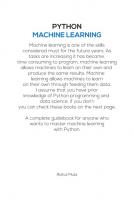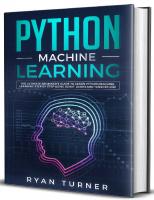Machine Learning Guide for Oil and Gas Using Python 9780128219294, 9781491989388, 1449369413
Machine Learning Guide for Oil and Gas Using Python: A Step-by-Step Breakdown with Data, Algorithms, Codes, and Applicat
332 95 115MB
English Pages 544 Year 2021
Table of contents :
Chapter 1. Introduction to machine learning and Python
Introduction
Artificial intelligence
Data mining
Machine learning
Python crash course
Anaconda introduction
Anaconda installation
Jupyter Notebook interface options
Basic math operations
Assigning a variable name
Creating a string
Defining a list
Creating a nested list
Creating a dictionary
Creating a tuple
Creating a set
If statements
For loop
Nested loops
List comprehension
Defining a function
Introduction to pandas
Dropping rows or columns in a data frame
loc and iloc
Conditional selection
Pandas groupby
Pandas data frame concatenation
Pandas merging
Pandas joining
Pandas operation
Pandas lambda expressions
Dealing with missing values in pandas
Dropping NAs
Filling NAs
Numpy introduction
Random number generation using numpy
Numpy indexing and selection
Chapter 2. Data import and visualization
Data import and export using pandas
Data visualization
Chapter 3. Machine learning workflows and types
Introduction
Machine learning workflows
Machine learning types
Dimensionality reduction
Chapter 4. Unsupervised machine learning: clustering algorithms
Introduction to unsupervised machine learning
K-means clustering
Hierarchical clustering
Density-based spatial clustering of applications with noise (DBSCAN)
Important notes about clustering
Outlier detection
Local outlier factor using scikit-learn
Chapter 5. Supervised learning
Overview
Linear regression
Logistic regression
Metrics for classification model evaluation
Logistic regression using scikit-learn
K-nearest neighbor
Support vector machine
Decisio
Random forest
Extra trees (extremely randomized trees)
Gradient boosting
Extreme gradient boosting
Adaptive gradient boosting
Frac intensity classification example
Handling missing data (imputation techniques)
Rate of penetration (ROP) optimization example
Chapter 6. Neural networks and Deep Learning
Introduction and basic architecture of neural network
Backpropagation technique
Data partitioning
Neural network applications in oil and gas industry
Example 1: estimated ultimate recovery prediction in shale reservoirs
Example 2: develop PVT correlation for crude oils
Deep learning
Convolutional neural network (CNN)
Convolution
Activation function
Pooling layer
Fully connected layers
Recurrent neural networks
Deep learning applications in oil and gas industry
Frac treating pressure prediction using LSTM
Chapter 7. Model evaluation
Evaluation metrics and scoring
Cross-validation
Grid search and model selection
Partial dependence plots
Size of training set
Save-load models
Chapter 8. Fuzzy logic
Classical set theory
Fuzzy set
Fuzzy inference system
Fuzzy C-means clustering
Chapter 9. Evolutionary optimization
Genetic algorithm
Particle swarm optimization
Chapter 1. Introduction to machine learning and Python
Introduction
Artificial intelligence
Data mining
Machine learning
Python crash course
Anaconda introduction
Anaconda installation
Jupyter Notebook interface options
Basic math operations
Assigning a variable name
Creating a string
Defining a list
Creating a nested list
Creating a dictionary
Creating a tuple
Creating a set
If statements
For loop
Nested loops
List comprehension
Defining a function
Introduction to pandas
Dropping rows or columns in a data frame
loc and iloc
Conditional selection
Pandas groupby
Pandas data frame concatenation
Pandas merging
Pandas joining
Pandas operation
Pandas lambda expressions
Dealing with missing values in pandas
Dropping NAs
Filling NAs
Numpy introduction
Random number generation using numpy
Numpy indexing and selection
Chapter 2. Data import and visualization
Data import and export using pandas
Data visualization
Chapter 3. Machine learning workflows and types
Introduction
Machine learning workflows
Machine learning types
Dimensionality reduction
Chapter 4. Unsupervised machine learning: clustering algorithms
Introduction to unsupervised machine learning
K-means clustering
Hierarchical clustering
Density-based spatial clustering of applications with noise (DBSCAN)
Important notes about clustering
Outlier detection
Local outlier factor using scikit-learn
Chapter 5. Supervised learning
Overview
Linear regression
Logistic regression
Metrics for classification model evaluation
Logistic regression using scikit-learn
K-nearest neighbor
Support vector machine
Decisio
Random forest
Extra trees (extremely randomized trees)
Gradient boosting
Extreme gradient boosting
Adaptive gradient boosting
Frac intensity classification example
Handling missing data (imputation techniques)
Rate of penetration (ROP) optimization example
Chapter 6. Neural networks and Deep Learning
Introduction and basic architecture of neural network
Backpropagation technique
Data partitioning
Neural network applications in oil and gas industry
Example 1: estimated ultimate recovery prediction in shale reservoirs
Example 2: develop PVT correlation for crude oils
Deep learning
Convolutional neural network (CNN)
Convolution
Activation function
Pooling layer
Fully connected layers
Recurrent neural networks
Deep learning applications in oil and gas industry
Frac treating pressure prediction using LSTM
Chapter 7. Model evaluation
Evaluation metrics and scoring
Cross-validation
Grid search and model selection
Partial dependence plots
Size of training set
Save-load models
Chapter 8. Fuzzy logic
Classical set theory
Fuzzy set
Fuzzy inference system
Fuzzy C-means clustering
Chapter 9. Evolutionary optimization
Genetic algorithm
Particle swarm optimization

- Author / Uploaded
- Hoss Belyadi
- Alireza Haghighat
- Similar Topics
- Computers
- Algorithms and Data Structures: Pattern Recognition









